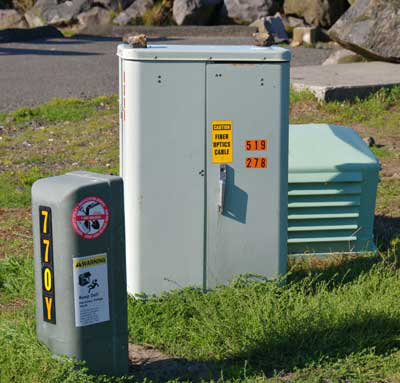Fiber optic has been widely used in the field of communication such as telecom, CATV, LAN, industrial, etc. However, even within communications applications, they are differ greatly in use and in methods of installation. For example, there are “outside plant” (OSP) fiber optics used in telephone networks, CATV, metropolitan networks, utilities, etc. or “premise” fiber optics adopted in buildings and campuses. And there exists fiber on “platform” like cars, planes and ships. Fiber optic is not all the same. This article will mainly focus on OSP installation in details.
A significant amount of fiber optics are used in telephone companies, CATV and the Internet. In fact, all of this fiber optic is single-mode fiber and most of it is adopted in outside buildings. It hangs from poles, or it is buried underground, pulled through conduit or even submerged underwater. Most of it goes relatively long distances, from a few hundred feet to hundreds of miles. Outside plant cables often have very high fiber counts, up to 288 fibers or more. Cable designs are optimized for the application: cables in conduit for pulling tension and resisting moisture, buried cables for resisting moisture and rodent damage, aerial for continuous tension and extreme weather while undersea for resisting moisture penetration.
After designing fiber optic networks, there comes the next step—to install it. Outside plant installation of fiber optics can be a diverse process, as it may include placing aerial or underwater cable, direct-buried cable, cable in conduit or installing conduit or innnerduct and then pulling cable.
OSP cables are generally loose tube, ribbon or slotted core design. And their jackets are chosen to withstand an outdoor environment appropriate for the application. Strength members must be strong enough to absorb all the tension loads in the installation process or long term loads from aerial installation. Cables usually include fiberglass rod stiffeners in the center to prevent kinking. Jackets may be doubled with armor between them to prevent rodent penetration or crushing or strength member to allow pulling by the jacket.
OSP installations in conduit may require lubrication to reduce frictional loads and/or intermediate pulls. Intermediate pulls require pulling the cable to a point, laying on the ground in a “figure 8” pattern to prevent putting a twist in the cable, then pulling the next section.
As we have mentioned above, OSP installation of fiber optics is rather diverse, and it is the diversity that makes it extremely important for the contractor to know the route of the cable to be installed intimately. Just as the estimator who should walk the route before beginning the estimating process, the contractor needs to see for themselves the actual situations they are going to encounter. That inspection allows them to determine what problems may be encountered, what special equipment may be needed and even double check that all the permits needed are in order.
OSP installation may need to position the supporting structures before starting the cable placement. New conduit or innerduct may need to be buried, or conduit already in place may need to be checked, old cables removed and new innerduct installed. Some buried cables even may require the installation of manholes or controlled-environment vaults for equipment and conduit.

Once the infrastructure is in place and the cabling pulled, it is time to splice the fiber optic. Now, scheduling the availability of appropriate fiber optic equipment is the concern. If the cable is to be spliced outdoors, a splice trailer is normally used, unless splices are being made on a pole or in a bucket, where a tent may be required in bad weather.
Each splice must be verified with an optical time-domain reflector (OTDR) test. Preferably, testing is done as each splice is made. To be efficient, a splicer will be on the job site, and a test tech will be at the other end of the cable with an OTDR to verify each splice. Splicing machines give an estimate of splice loss, but going back later, opening a splice closure and resplicing is an expensive proposition.
Cables will be terminated inside facilities where they will connect to communications equipment. OSP cables generally do not meet National Electrical Code flammability requirements, so the cable entering a building must be terminated or spliced to indoor cables soon after entry. Some OSP cables have double jackets, an outer one for outdoors and an inner one rated for indoor use, so the outer jacket can be stripped off inside the building and the cable run to the equipment room. Cables terminated in pedestals or vaults do not have this requirement.
Generally, single-mode OSP cables will be terminated by splicing pigtails onto each fiber, and splices will be placed in a splice closure. Multimode fibers can be handled the same way or terminated directly onto the fibers. Most OSP cables will require installing a breakout kit, which sleeves each fiber in a tube rugged enough for direct termination.
OSP safety is a very critical issue. Routes should be cleared with “One Call” or “Call Before You Dig” services to ensure no buried cables or pipes are in the proposed route. Installers working with cable-placing machinery need to be well trained in how to operate them safely. Aerial installations are particularly dangerous, since poles usually have electrical cables too close for comfort. Every OSP job should have posted safety procedures and all personnel should be briefed in their use.
In conclusion, with the advent of fiber optics used in communication networking, outside plant fiber optic installation has become a common phenomenon. What we discussed in this article may simply provider you an introduction and guideline to OSP installation, the real installation environment can be more complicated and time-consuming. So specialized personnel are essential to ensure smooth and successful OSP installation.